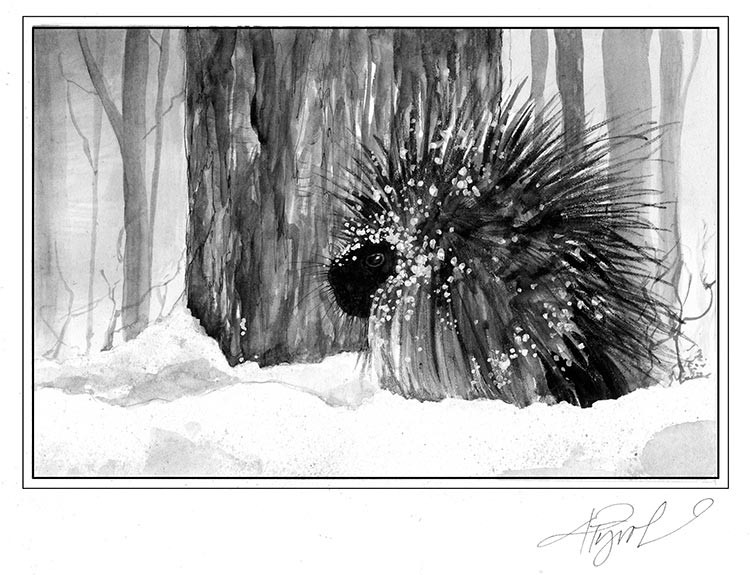
I once lived in a cottage perched atop a sloping field in Western Massachusetts. It was the lone structure at the edge of undeveloped forest and sat far from the road. The cottage had a large front deck with an expansive view and a smaller one in back that faced the forest. It was under the small deck that a porcupine took up residence one fall, for a stay that turned out to be briefer than I would have liked.
Since he wasn’t damaging the house, and didn’t seem aggressive, I didn’t mind his presence. Until my dog, Beckett, met him. Beckett, a 55-pound mixed breed, could not learn the porcupine lesson. He was always certain that this time – this time – he would be victorious. Fed up with yanking quills out of him or taking him to the vet after especially bad encounters, I was desperate to figure out how to share the space peaceably with our resident rodent.
Which is what porcupines are – rodents: the second largest rodent in North America, beavers being the largest. They range in weight from 12 to 35 pounds and can grow to about 3 feet, tip to tail. Porcupines are herbivores, and with no need to pursue prey their movement tends to be ponderous. (Surprisingly, however, they are good swimmers). There are 29 species world-wide, but only one, the North American porcupine (Erethizon dorsatum), resides in the United States. While the porcupines in Africa and Europe live in large family groups, those found in the Americas are generally solitary.
What all the species have in common, of course, are quills. When porcupines are born, the quills are soft, but they harden within an hour of birth. Some species, such as the African crested porcupine, which can weigh up to 66 pounds, have very long quills and when threatened, will turn around and charge an attacker. The North American variety does nothing quite so brazen. Instead, when attacked, they tuck their noses between their front legs and simply turn around. If necessary they will strike with their tails.
It’s generally an effective defense, as the quills are easily released from the porcupine and puncture the skin of any predator that makes contact. Quills lost during an attack are regrown, and an adult porcupine can sport up to 30,000 of them.
North American porcupines have a secret weapon not found in Old World species: at the end of each quill are hundreds of tiny barbs. Researchers have found that barbed quills are four times harder to extract than non-barbed ones.
I can attest to just how hard they are to remove, especially from the snout of an agitated dog. To put an end to Beckett’s fruitless and painful pursuits, I started watching the porcupine, hoping to figure out his schedule. It proved to be quite predictable. Every morning around 7, he would waddle out from under the deck and disappear into the woods. He would return via the same path around dusk. Sometimes, before returning to his digs, he would climb the hemlock tree next to the cottage to snack on the branches.
Once the porcupine left for “work,” I would wait a while to make sure he was well out of sight before I let Beckett outside. They never had another encounter, and we settled into a harmonious coexistence.
I didn’t regard the porcupine as anything but a wild animal – it didn’t occur to me to feed him or give him a nickname. He was always simply “the porcupine.” But I loved to watch him and had grown attached to having him around.
One day in the spring, I was removing the hay bales I had placed around the cottage’s crawl space to keep out the cold. As I pulled one away, I was startled to find the porcupine lying with his back to me. I put Beckett in the house and went to work in another part of the yard to give him time to wake up and get moving. After a while it occurred to me he wasn’t asleep. With a garden rake and a lot of effort I was able to pull his body out from under the cottage. He could not have been dead long as there were no signs of decomposition. There were also no obvious signs of disease or trauma, except for some dried blood around his nose.
Using the rake, I heaved the porcupine onto a plastic sled and went up the path he had ambled along hundreds of times. I trudged far into the woods, dragging the dead animal behind me. When I decided we were far enough from the cottage I tipped the sled, and he tumbled onto the soft wet ground. I looked at him one last time and then headed home with the empty sled.


Discussion *